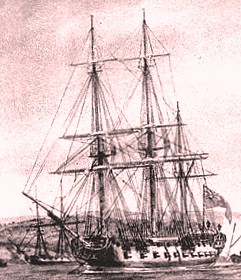Burning of Richland
The burning of Richland was the Fredericksburg area’s only known Revolutionary War fighting between organized units. The shooting part of the Revolution came to Stafford in July 1776, 15 months after Virginia’s Royal Governor, John Murray, 4th Earl of Dunmore, declared his colony in rebellion and a year after he moved the seat of his “government” to a British fleet that would raid up and down the Chesapeake and its tributaries.
It began with four British warships sailing past on the Potomac on July 22, and continued the next day, when at least one of the four, the 44-gun, two decker HMS Roebuck, returned to dispatch landing craft to William Brent’s Richland. Richland, centered around what was described as an “elegant brick house,” was situated on the Widewater peninsula roughly three-quarters of the way up (northwest along) its Potomac shoreline. Brent owned land in Prince William County as well as in Stafford, and was captain of the Prince William militia:
On Monday, July 22, the Roebuck, Mercury, Otter, and an armed ship, came up Potomack, and anchored about two miles below Dumfries, where the river is yet quite fresh. On Tuesday, about twelve o’ clock, they sent off two tenders, a gondola covered, and eight boats, mostly large, and full of men, consisting of the remains of the Fourteenth Regiment, Marines, &c. They landed at William Brent’ s Esq.; where about sixty of the Stafford Militia were posted, without any cover. The gondola, drawing but sixteen inches water, run in close to the shore, and, with a nine-pounder and grape shot, obliged the Militia to retreat, when about one hundred and fifty men landed and burnt the house, out houses, hay stacks, &c., and intended to have burnt Mr. Brent’ s fine merchant mill, and several other houses along shore….
…on the Roebuck’ s observing that the Prince William Militia were on their march to Mr. Brent’ s, she hoisted a white flag, and their men immediately retreated, so that no further damage was done. The fleet having taken in fresh water, fell down the river the next day. I followed them to the Narrows, about thirty miles below this, and found they had done no other mischief. As I returned on Friday, I was informed that three white men and four negroes were found dead on the shore, two of the whites sewed up in hammocks and shot through the breast; they had fine Holland shirts, and are supposed to be of some distinction; and a gold laced hat was found, with a bullet hole through both sides of the crown. As the Riflemen had some fair shot at them, it is not doubted but several are killed. No damage was done on the side of the Militia.
Evidently, the Stafford militia had helped bring the British “mischief” down upon their heads by becoming intoxicated, taunting the enemy afloat, and then falling asleep. Enough, however, recovered their faculties in time to inflict casualties upon the landing force. The wonderfully named Captain Andrew Snape Hamond, commander of the Roebuck (and destined not only for a knighthood and a baronetcy but also for service on the court martial that tried the Bounty mutineers), acknowledged six wounded at Widewater. Yet a letter that George Washington’s stepson, John Parke Custis, wrote to his stepfather tallied closely with the passage quoted above by crediting a Staffordian named Combs with three British dead. Hamond also specified that the landing craft included a row galley—one of the more exotic vessels to appear in combat in the annals of Fredericksburg-area military history—and stated that the force sent ashore totaled 108 Royal Marines and regulars from the 14th Regiment of Foot.

